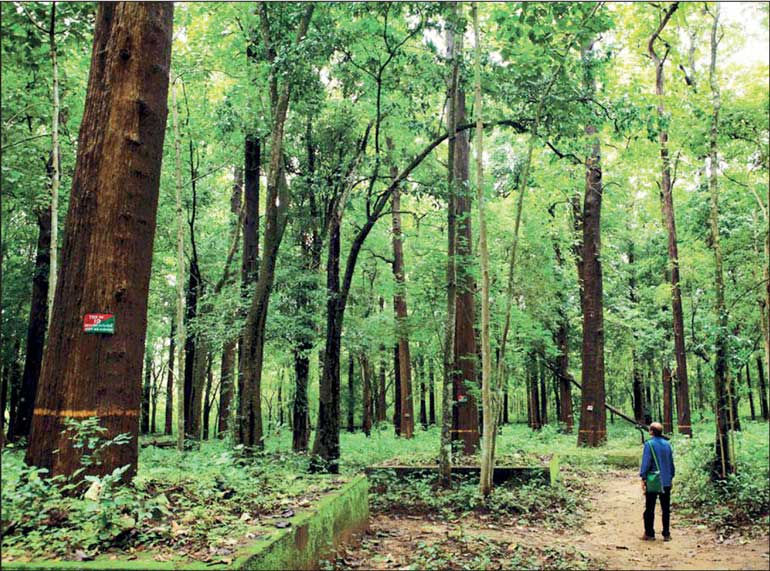Monday Apr 21, 2025
Monday Apr 21, 2025
Saturday, 23 March 2024 00:00 - - {{hitsCtrl.values.hits}}

A sustainable future depends on investments in forest protection and restoration
By Dr. (Eng) A.L. Ediriweera, C. Env (IEPSL)
21 March is International Forest Day, a day to celebrate and spread awareness of the value of forests and trees. The theme for this year, “Forest and innovation: New solutions for a better world,” emphasises how critical it is to find creative solutions to the problems that confront our forest areas. A sustainable future depends on investments in forest protection and restoration, which will help with everything from reducing the effects of climate change to protecting biodiversity and assisting human populations.
Numerous essential ecosystem services that are cultural, regulating, supporting, and provisioned by forests are valuable on a local and global scale. The equilibrium of carbon dioxide and oxygen between plants and animals is preserved by forests. The water cycle and temperature are controlled by forests. They transpire a lot of water vapour into the environment, which raises atmospheric humidity. Additionally, the forest can shield villages and residences from severe winds. There is water in the forest. Water is stored by the trees and the soil they create for periods when there isn’t any rain. Water flow across the land is regulated by the forest.
Trees and forests thus took on symbolic divine characteristics, or were seen to represent superlative forces such as courage, endurance or immortality. They were the means of communication between worlds and some societies made them into magical totems.
The mechanisms that sustain all life on earth, including human existence, depend on biodiversity. The healthy ecosystems that give us the oxygen to breathe and the food to eat are dependent on a diverse range of animals, plants, and microorganisms. People also appreciate its natural beauty.
Climate change, pollution, habitat destruction, invasive alien species, and over-exploitation of the natural environment are the main causes of biodiversity loss. The loss of tree cover is not always caused by deforestation, which is usually defined as the permanent removal of natural forest cover by humans. For this reason, biodiversity is crucial. The total disappearance of tree cover for whatever reason is referred to as tree cover loss.
It encompasses loss that is either temporary or permanent, caused by humans as well as natural disruptions. Examples of losses in tree cover that might not fit the concept of deforestation include storm damage, fire, illness, and logging losses in producing forests.
Steps to stop the loss of biodiversity are whenever feasible, purchase fair-trade and sustainable goods, avoid using lawn and garden chemicals, plant a tree for biodiversity, protect local habitats, eat locally and organically, make a biodiversity patch in your yard, and teach young people about biodiversity.
Climate change presents new survival concerns for both humans and wild animals as rising sea levels, melting glaciers, warmer oceans, more frequent and severe droughts, storms, heat waves, and rising sea levels can all directly kill animals, ruin their habitats, and have a disastrous effect on people’s lives and societies. Future impacts of global climate change could include longer droughts in some areas, a rise in wildfire frequency, and stronger winds and rainfall from tropical storms.
Mitigation, or lowering and stabilising the atmospheric concentrations of heat-trapping greenhouse gases, and adaptation, or making necessary adjustments to the climate change already underway, are the two main strategies for responding to climate change. Indeed, although stopping global warming will not happen quickly, we can restrict its amount and decrease its rate of increase by lowering the amount of heat-trapping gases and black carbon that humans emit into the atmosphere.
Hence to live on a healthy world conserve energy at home, alter the energy source in your house, pedal, cycle, or use public transportation, make the switch to an electric car, think about your trip, cut back, repurpose, fix, and recycle, consume more vegetables and discard less food.
We can slow down climate change although we cannot stop it. Preventing the most severe consequences of climate change will require achieving “net zero” carbon emissions by 2050 or before. Net zero refers to carbon emissions that are equal to removals from the atmosphere. The unregulated use of fossil fuels has contributed greatly to the atmospheric concentration of greenhouse gases, mostly carbon dioxide, over the past
150 years.
Discover Kapruka, the leading online shopping platform in Sri Lanka, where you can conveniently send Gifts and Flowers to your loved ones for any event including Valentine ’s Day. Explore a wide range of popular Shopping Categories on Kapruka, including Toys, Groceries, Electronics, Birthday Cakes, Fruits, Chocolates, Flower Bouquets, Clothing, Watches, Lingerie, Gift Sets and Jewellery. Also if you’re interested in selling with Kapruka, Partner Central by Kapruka is the best solution to start with. Moreover, through Kapruka Global Shop, you can also enjoy the convenience of purchasing products from renowned platforms like Amazon and eBay and have them delivered to Sri Lanka.
Discover Kapruka, the leading online shopping platform in Sri Lanka, where you can conveniently send Gifts and Flowers to your loved ones for any event including Valentine ’s Day. Explore a wide range of popular Shopping Categories on Kapruka, including Toys, Groceries, Electronics, Birthday Cakes, Fruits, Chocolates, Flower Bouquets, Clothing, Watches, Lingerie, Gift Sets and Jewellery. Also if you’re interested in selling with Kapruka, Partner Central by Kapruka is the best solution to start with. Moreover, through Kapruka Global Shop, you can also enjoy the convenience of purchasing products from renowned platforms like Amazon and eBay and have them delivered to Sri Lanka.